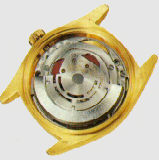
 |
 Above: Abraham-Louis Perrelet Right: An automatic watch made by Perrelet Below: John Harwood Below right: Replica of Harwood's stemless self-winding wristwatch, which the wearer set by turning the bezel  |  |
Since the revival of the mechanical watch in the late '80s, one special of mechanical has become a fast favorite among timepiece aficionados. It is the automatic, or self-winding watch, whose allure comes from its combination of traditional mainspring-and-balance-wheel technology with the convenience of no winding. Nearly every company that makes mechanicals offers automatic models.
But the development of the self-winding watch was anything but automatic. In fact, it took more than a century and a half. The concept was invented around 1770 by the Swiss watchmaker Abraham-Louis Perrelet, a teacher of the great Abraham-Louis Breguet and a well-known craftsman in his own right. In Perrelet's day, winding one's watch was a bit of a pain, as all watches were wound with keys, which were easily misplaced Perrelet's idea was to fit onto the watch movement a, rotor that swiveled in a 360-degree arc and, as it did so, wound the watch's mainspring. The happy watch owner could, presumably, forget the tiresome task of winding his watch and throw away the key forever.
But there was one glitch: The rotor moved only when the watch moved. And in the case of pocket watches, that was not very often not often enough, anyway, to keep the watch ticking.
Breguet and other Swiss watchmakers tried to develop improved self-winding movements incorporating weights rather than a rotor, but to little avail. Insufficient power remained a problem; so did the noise of the weights hitting the buffers. The automatic remained a non-starter.
It wasn't until watches moved from pockets to wrists after World War I that self-winding had a chance. John Harwood, a British soldier, realized that wristwatches were subject to much more motion than pocket watches. He dusted off the old idea of a self-winding movement and applied it to a wristwatch.
Harwood was inspired less by the inconvenience of daily winding than the fact that, during the rigors of trench warfare, the hole that held the winding stem allowed dirt to enter the case and damage the movement. His stemless automatic wristwatch (the wearer set it by rotating the bezel) was patented in 1923 and went into production in 1926.
It was a nice try. It was not, however, the long-sought solution to the self-winding quandary. Harwood's watch used an oscillating rotor that swung in a 130-degree arc, stopped at either end by a buffer. As the weight hit the buffers, it shook the movement, and, over time, damaged it.
Rolex finally met the 160-year-old challenge. It did so by studying the history books. In 1931 it introduced a watch with a rotor like Perrelet's, which provided plenty of energy to wind the mainspring while leaving the movement unshaken. It was called the Oyster Perpetual, an addition to its line of water-resistant Oyster watches, introduced in 1927.
Automatic winding became a much coveted staple of Swiss luxury watches until the quartz age. Now that mechanical watches are back, Swiss firms are working non-stop at launching new automatic models. They range from thick, masculine "high-mech" looks loaded with sub-dials and push pieces to
 | The rotor self-winding mechanism in a Rolex oyster perpetual |